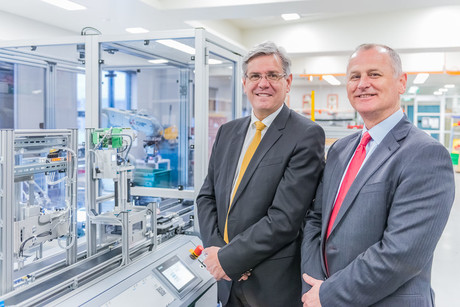Siemens announces $135m high-tech digitalisation grant

Siemens has announced the largest ever software grant in Australia to support Swinburne University of Technology establish what is believed to be Australia’s first Industry 4.0 Factory of the Future facility in Hawthorn, Victoria. The $135 million industrial digitalisation software grant will be used to fully digitalise the Swinburne University of Technology Factory of the Future.
The software will help develop the workforce of the future across the entire work lifecycle from apprenticeships to PhDs.
At the announcement, Jeff Connolly, the chairman and CEO of Siemens Australia, said this grant will support Victoria and Australia by preparing students so they can participate in the many opportunities that digitalisation provides within the new innovation economy that is globally interconnected.
“This is about jobs of the future today,” he said. “I’m proud to be standing here today side by side with Swinburne University of Technology announcing the largest ever industrial software grant in Australia. Our country’s future relies on companies working with key educational and research institutions to get our workforce ready for the Fourth Industrial Revolution.
“The world is changing rapidly through technology and Australia needs to equip our future generations and our existing workforce with the necessary capabilities and tools to make things faster, cheaper and better — ultimately, this is about jobs and competition.”
The announcement coincides with the 145th anniversary of the Siemens-commissioned Darwin to Adelaide telegraph — another technology breakthrough that transformed the fabric of Australia.
“For Siemens to be here at least another 145 years, we need a viable and successful base of industry, manufacturing and infrastructure along with a highly skilled workforce driven by forward-thinking educators,” said Connelly. “So it’s vitally important that our future generations are equipped with the globally competitive technology and skills to take us on that journey.”
Siemens provides a suite of advanced PLM (product lifecycle management) software and new-generation, cloud-based, Internet of Things (IoT) platform Mindsphere, which will allow students and researchers to have access to the same apparatus being used by leading industries on the most advanced projects, according to Connolly, who is also chair of the Prime Minister’s Industry 4.0 Taskforce.
“These are the same tools used to create digital shipyards for the US Navy. The same software used to design, build and operate everything from the latest oil and gas platforms to high-tech production lines such as the Maserati Ghibli. We provide the innovation tools so that Australia can provide the ingenuity,” Connolly said.
“Imagine creating a digital twin, not only of the product but of the entire manufacturing process, so you don’t need to have costly and time-consuming physical prototypes. Everything from the assembly line to tooling, ergonomics and resources can be fully simulated digitally. This is exactly what our software grant will help students achieve in Swinburne’s Factory of the Future.”
The grant also includes a co-contribution by Swinburne for initialisation and ongoing interaction with and global support by Siemens expert software engineers.
According to Professor Aleksandar Subic, Deputy Vice-Chancellor (Research and Development) and chair of Industry 4.0 Testlabs on the Prime Minister’s Industry 4.0 Taskforce, digitalisation of manufacturing is critical to help Australian industry transition to the future.
“We’re immersed in the Fourth Industrial Revolution and we want to make sure that students and researchers are equipped with the required advanced capabilities and technologies to help Australia access global value chains. The international competition will be fierce in the manufacturing domain, which is why this development is so timely and critical,” said Subic.
“I have experienced the Siemens automation technology and digitalisation software and hardware first-hand in Germany and the US, and can see how this approach will help transform our manufacturing sector and develop a future workforce to participate and compete globally.
“We have already made significant progress in aligning our research and education strategy with the Industry 4.0 roadmap in collaboration with our industry partners both locally and internationally. The partnership with Siemens and our co-investment in digitalising the Swinburne Factory of the Future will allow us to make the step change in how we support our SMEs and develop future graduates across the entire education lifecycle — from apprenticeships to PhDs. We are committed to transforming industries and developing the workforce of the future in support of a more competitive Australia.
“The fully digitalised Swinburne Factory of the Future will set an Industry 4.0 benchmark and provide an environment for workforce transformation that is in line with the most advanced economies in the world. This is an aspiration that we shared on the PM’s Industry 4.0 Taskforce,” he continued.
Government investing over $330m to lower emissions in industry
The Australian Government has announced it is co-investing over $330 million to support...
Consultation open for Solar Sunshot program
Consultation has opened on the design of the $1 billion Solar Sunshot program announced by the...
Advanced Manufacturing Research Facility to open this year
The Western Parkland City Authority said the AMRF will play an important role in the...














